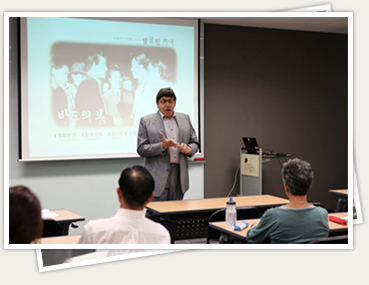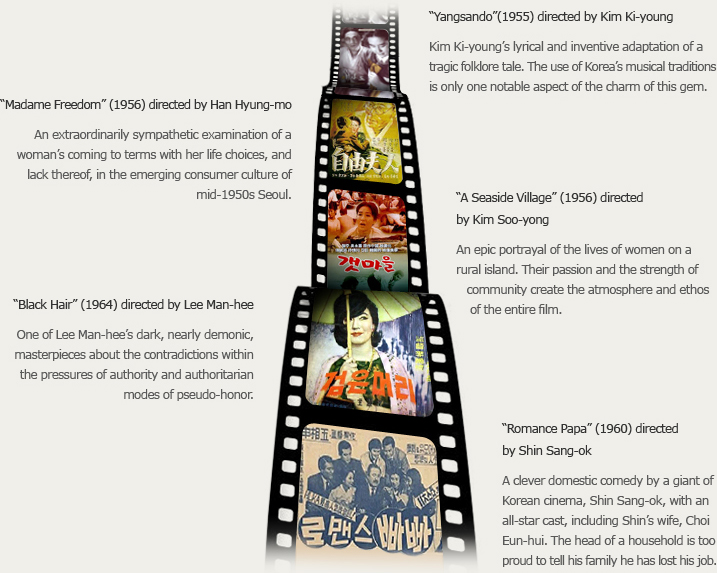The Korea Foundation Cultural Center presents a biweekly movie screening and discussion program to introduce classical Korean films to foreign residents in the country. Titled “Treasures of Korean Cinema,” the program began on September 26 to help foreign residents acquire a better understanding of Korean culture through the showing of Korean feature films and ensuing discussions.
The program introduces a selection of Korean movies, such as “Spring on the Korean Peninsula,” “Yangsando,” and “Madame Freedom,” mostly produced between the 1940s and 1960s, at the budding stage of Korea’s modern film industry. The viewing of each movie is followed by a brief lecture and group discussion, presided over by Professor Earl Jackson of the Korea National University of Arts (KNUA). The program continues until December 12.
Dr. Jackson, 57, an ardent lover of Korean cinema, is the program’s creator. He explained about the film series and its background in a recent interview.
How was this cinema program launched?
This spring, when I was giving a lecture on Korean film at the Seoul Museum of History, I met Ms. Marita Seidt, who is the wife of the German ambassador to Korea. She recommended that I present a lecture series on Korean movies for foreign residents in Korea. Then, I made inquiries with related organizations, including Seoul City Hall, and the Korea Foundation readily agreed to accept my proposal and this program came into being, about six months later.
You show only ‘classic’ moves. Who selected them?
Of course, I selected the films. To me, they all are like treasures hidden in a forest. I selected them because I thought no one else would introduce these movies, except for me. However, since they are quite old, the story tends to unfold at a slow tempo and some background knowledge is needed for a clearer understanding of the details.
How is did you became so deeply interested in Korean movies?
I received my MA degree from Cornell University and my doctorate from Princeton University, both in comparative literature with a focus on Japanese literature, and then taught East Asian studies at the University of Minnesota, and comparative literature at the University of California, at Santa Cruz. From this academic background alone, I am not a film specialist. However, I have loved movies since my childhood and I would walk several miles to see foreign movies while I was a college student.Of course, at that time, I didn’t watch any Korean movies. The time when movies were born is similar to the emergence of Freud’s psychoanalysis theory. Given that, I think, movies are the genre for telling stories about people. In addition, composite arts that embrace politics, culture, history, and psychology, can be a useful tool to understand other cultures, since it is like a window on the world.
What particular characteristics of Korean movies do you believe differentiate them from American films?
Korean movies are very attractive in that they deal with human lives and humanism in regard to Korea’s two great national tragedies: the Japanese colonial rule of Korea and the Korean War. What differentiates them from Hollywood movies is that while Americans make films for young audiences by investing huge amounts of money, Koreans make films for adult viewers based on their outstanding creativity. For example, movies directed by Lee Man-hee did not cost that much but they include many impressive and powerful scenes. On the other hand, millions of dollars were spent to produce the Hollywood movie “Titanic,” but I wonder who would remember such a movie for long.
When did you develop a connection with Korea?
At an academic conference held in Hawaii in 2003, I met Professor Kim So-young of the KNUA, and then I came to teach at her school in 2004, as a visiting professor. By then, I had developed a keen interest in Korean culture, and particularly its cinema. I realized that I needed to look at things from a Korean perspective to better understand East Asia. Before that, I used to view Asia through Japan, and I later realized know how wrong I had been. Then, I began teaching American poetry at Korea University in 2006, and since 2009, I have been at the KNUA. ‘Don’t Imitate Hollywood’ While he was teaching at the Department of English Literature of Korea University, he would show Korean movies in his classes. The students responded favorably, but the school authorities did not support his instruction method, which later made him move to the KNUA.
'Don't Imitate Hollywood'
while he was teaching at the Department of English Literature of Korea University, he would show Korean movies in his classes. The students responded favorably, but the school authorities did not suppport his instruction method, which later made him move to the KNUA.
 What courses do you teach at the KNUA?
What courses do you teach at the KNUA?
I teach an introduction to film theory at the college, and a course related to Japanese cinema at the graduate school. In addition, while serving as co-director of the Trans Asia Screen Culture Institute along with Professor Kim So-young, I help to organize international academic conferences and carry out cinema-related regional studies.
What does your research on Korean cinema involve?
I have many conversations with other KNUA professors and often visit the Korean Film Archive to watch old Korean movies. I once viewed five movies in one day. So far, I think I have watched more than 300 Korean movies.
Who do you like most among Korean film directors?
I like Lee Man-hee, Kim Ki-young, and Park Chan-wook, as well as Kim Tae-yong for “The Birth of a Family” and Lee Sang-woo who produces independent movies. In particular, I believe that all Korean students should see the movie “Hanyeo” (The Housemaid), directed by Kim Ki-young. Students think that they already know a lot about Korean movies, but in fact they don’t know that much about them, especially the black-and-white movies.
Do you have any ideas for the Korean film industry?
Well, I think it should probably consider re-introducing the strict screen quota system. In the 1990s, many gem-like Korean movies were made and this was largely thanks to the screen quota system. Under the revised system, the quality of Korean films has deteriorated greatly, and we are now witnessing what you can call a crisis for Korean movies. In addition, I’d like to say that you should stop trying to follow Hollywood.
Professor Jackson is not a simple fanatic of Korean movies. He is also a filmmaker who participates in film production. Together with Professor Kim So-young, he made a short experimental travelogue, “Tabi/T’abi,” which was submitted to the Seoul Experimental Film Festival in 2007. He also contributed to writing the screenplay for the film “Mirror” in 2009. And he even debuted as an actor in the film “Barbie,” directed by Lee Sang-woo and presented to this year’s Busan International Film Festival (BIFF). In the movie, he plays the role of an American who visits Korea to adopt a daughter. While regularly participating in the BIFF, he serves as a knowledgeable advocate of Korean cinema among many foreigners.
“With the English subtitles developed by the Korean Film Archive, foreigners will have no problem in understanding the movies. Many of those who attended my first lecture were reading through the KF Newsletter. If they know about this program, I think more people will come,” he said.

Kim Sung-hee Columnist
 한국국제교류재단
한국국제교류재단












